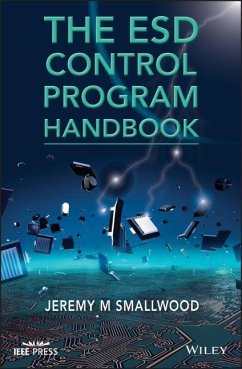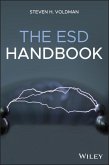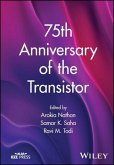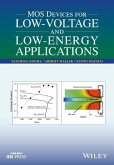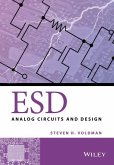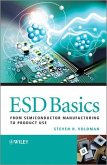Provides the understanding and practical skills needed to develop and maintain an effective ESD control program for manufacturing, storage, and handling of ESD sensitive components
This essential guide to ESD control programs explains the principles and practice of ESD control in an easily accessible way whilst also providing more depth and a wealth of references for those who want to gain a deeper knowledge of the subject. It describes static electricity and ESD principles such as triboelectrification, electrostatic fields, and induced voltages, with the minimum of theory or mathematics. It is designed for the reader to "dip into" as required, rather than need to read cover to cover.
The ESD Control Program Handbook begins with definitions and commonly used terminology, followed by the principles of static electricity and ESD control. Chapter 3 discusses ESD susceptible electronic devices, and how ESD susceptibility of a component is measured. This is followed bythe "Seven habits of a highly effective ESD program", explaining the essential activities of an effective ESD control program. While most texts mainly address manual handling of ESD susceptible devices, Chapter 5 extends the discussion to ESD control in automated systems, processes and handling, which form a major part of modern electronic manufacture.
Chapter 6 deals with requirements for compliance given by the IEC 61340-5-1 and ANSI/ESD S20.20 ESD control standards.
Chapter 7 gives an overview of the selection, use, care and maintenance of equipment and furniture commonly used to control ESD risks. The chapter explains how these often work together as part of a system and must be specified with that in mind.
ESD protective packaging is available in an extraordinary range of forms from bags, boxes and bubble wrap to tape and reel packaging for automated processes. The principles and practice of this widely misunderstood area of ESD control are introducedin Chapter 8. The thorny question of how to evaluate an ESD control program is addressed in Chapter 9 with a goal of compliance with a standard as well as effective control of ESD risks and possible customer perceptions.
Whilst evaluating an existing ESD control program provides challenges, developing an ESD control program from scratch provides others. Chapter 10 gives an approach to this.
Standard test methods used in compliance with ESD control standards are explained and simple test procedures given in Chapter 11.
ESD Training has long been recognised as essential in maintaining effective ESD control. Chapter 12 discusses ways of covering essential topics and how to demonstrate static electricity in action. The book ends with a look at where ESD control may go in the near future.
The ESD Control Program Handbook:
_ Gives readers a sound understanding of the subject to analyze the ESD control requirements of manufacturing processes, and develop an effective ESD control program
_ Provides practical knowledge, as well as sufficient theory and background to understand the principles of ESD control
_ Teaches how to track and identify how ESD risks arise, and how to identify fitting means for minimizing or eliminating them
_ Emphasizes working with modern ESD control program standards IEC 61340-5-1 and ESD S20:20
The ESD Control Program Handbook is an invaluable reference for anyone tasked with setting up, evaluating, or maintaining an effective ESD control program, training personnel, or making ESD control related measurements. It would form an excellent basis for a University course on the subject as well as a guide and resource for industry professionals.
Hinweis: Dieser Artikel kann nur an eine deutsche Lieferadresse ausgeliefert werden.
This essential guide to ESD control programs explains the principles and practice of ESD control in an easily accessible way whilst also providing more depth and a wealth of references for those who want to gain a deeper knowledge of the subject. It describes static electricity and ESD principles such as triboelectrification, electrostatic fields, and induced voltages, with the minimum of theory or mathematics. It is designed for the reader to "dip into" as required, rather than need to read cover to cover.
The ESD Control Program Handbook begins with definitions and commonly used terminology, followed by the principles of static electricity and ESD control. Chapter 3 discusses ESD susceptible electronic devices, and how ESD susceptibility of a component is measured. This is followed bythe "Seven habits of a highly effective ESD program", explaining the essential activities of an effective ESD control program. While most texts mainly address manual handling of ESD susceptible devices, Chapter 5 extends the discussion to ESD control in automated systems, processes and handling, which form a major part of modern electronic manufacture.
Chapter 6 deals with requirements for compliance given by the IEC 61340-5-1 and ANSI/ESD S20.20 ESD control standards.
Chapter 7 gives an overview of the selection, use, care and maintenance of equipment and furniture commonly used to control ESD risks. The chapter explains how these often work together as part of a system and must be specified with that in mind.
ESD protective packaging is available in an extraordinary range of forms from bags, boxes and bubble wrap to tape and reel packaging for automated processes. The principles and practice of this widely misunderstood area of ESD control are introducedin Chapter 8. The thorny question of how to evaluate an ESD control program is addressed in Chapter 9 with a goal of compliance with a standard as well as effective control of ESD risks and possible customer perceptions.
Whilst evaluating an existing ESD control program provides challenges, developing an ESD control program from scratch provides others. Chapter 10 gives an approach to this.
Standard test methods used in compliance with ESD control standards are explained and simple test procedures given in Chapter 11.
ESD Training has long been recognised as essential in maintaining effective ESD control. Chapter 12 discusses ways of covering essential topics and how to demonstrate static electricity in action. The book ends with a look at where ESD control may go in the near future.
The ESD Control Program Handbook:
_ Gives readers a sound understanding of the subject to analyze the ESD control requirements of manufacturing processes, and develop an effective ESD control program
_ Provides practical knowledge, as well as sufficient theory and background to understand the principles of ESD control
_ Teaches how to track and identify how ESD risks arise, and how to identify fitting means for minimizing or eliminating them
_ Emphasizes working with modern ESD control program standards IEC 61340-5-1 and ESD S20:20
The ESD Control Program Handbook is an invaluable reference for anyone tasked with setting up, evaluating, or maintaining an effective ESD control program, training personnel, or making ESD control related measurements. It would form an excellent basis for a University course on the subject as well as a guide and resource for industry professionals.
Hinweis: Dieser Artikel kann nur an eine deutsche Lieferadresse ausgeliefert werden.

